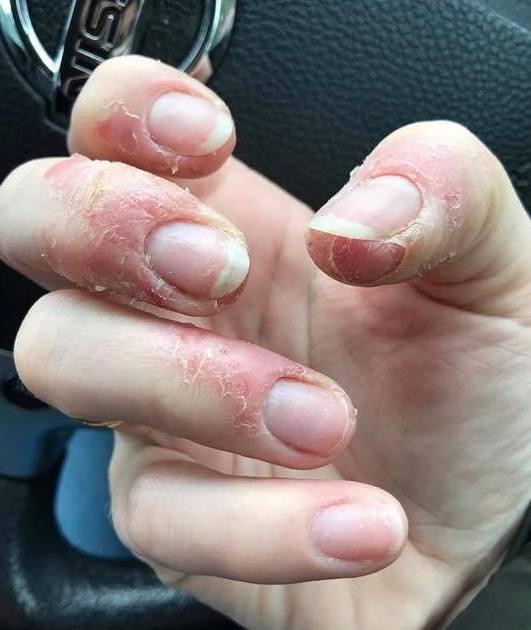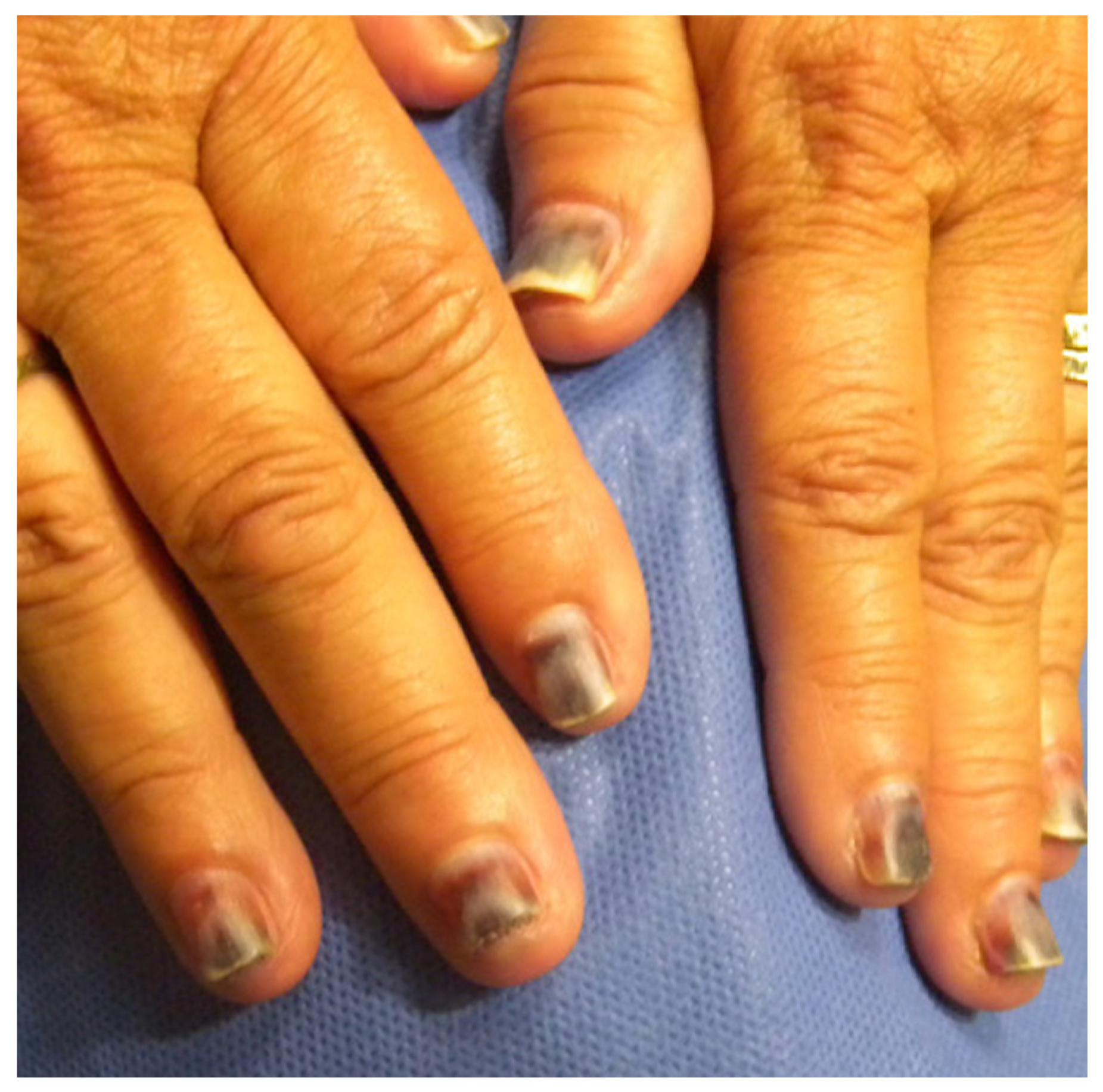Contact Dermatitis From Nails: What You Need To Know & How To Avoid It
Could the pursuit of perfectly manicured nails be secretly undermining your skin health? Contact dermatitis, a common inflammatory skin condition, is a potential hazard for anyone who regularly gets their nails done, and especially for nail technicians.
The aesthetic industry, with its allure of transformative beauty, sometimes harbors hidden risks. Contact dermatitis, a form of skin irritation, emerges when the skin comes into contact with an allergen or irritant. It can manifest as redness, itching, swelling, and even painful blisters. For those who spend hours in close proximity to nail products, like nail professionals, the risk is amplified. The chemicals in acrylics, gels, and polishes, while creating stunning results, can also trigger this unwelcome reaction.
This article delves into the intricacies of contact dermatitis, exploring its causes, symptoms, and the critical steps nail professionals and enthusiasts can take to protect their skin and careers. From the common culprits in nail products to the simple yet effective measures that can mitigate risk, this is your guide to navigating the world of manicures safely.
- Carol Hannah Logans Wedding A Creative Elegant Celebration
- Free Movies Tv Shows Your Guide To Streaming Without Subscriptions
Contact dermatitis can manifest in various ways. It often appears as a rash, which may develop anywhere on the body, but is frequently noticed near the nails. This rash is characterized by raised, itchy bumps that can be red and sometimes accompanied by pain. The duration of the rash can fluctuate, lasting from a few days to a couple of weeks, depending on the severity and the effectiveness of treatment.
As a nail professional, you must know how to manage and avert contact dermatitis, because it can bring a full stop to your career, or at least significantly debilitate it. Fortunately, this is completely avoidable with some precautions in the salon that you can embrace as soon as you read this article. One simple solution is to wear gloves.
Allergic contact dermatitis (ACD) is a type of skin reaction caused by an allergic response to a substance. Common triggers in the realm of nail cosmetics include acrylates (specifically, methacrylates), which are used in various nail products, including acrylics and gel polishes. Irritant contact dermatitis, on the other hand, results from direct skin contact with irritating substances or environmental factors that damage the skin's surface, leading to a disruption of the skin barrier.
- Subhashree Sahu Mms Scandal Privacy Leaks And Online Exploitation
- Eriq La Salle Angela Johnson Unveiling The Man Behind The Fame
The high solvent concentration in some nail products makes irritant contact dermatitis more likely than allergic contact dermatitis. They may irritate and dry the nail plate and surrounding skin. If used excessively they can cause nail dryness and brittleness.
Here's a table summarizing key information about contact dermatitis related to nail products:
| Aspect | Details |
|---|---|
| Condition | Contact Dermatitis (CD) |
| Type |
|
| Common Causes |
|
| Symptoms |
|
| Affected Areas |
|
| Duration of Rash | Few days to a couple of weeks. |
| Risk Factors for Nail Professionals |
|
| Preventive Measures |
|
| Exposure Statistics |
|
| Additional Risks |
|
| Key Chemicals |
|
The skin under the nail begins to peel and fingertips/pads become itchy. Some individuals are prone to picking their skin and cuticles, making them more susceptible. The impact of gel nails, although game-changing for some, highlights the potential for issues when the skin is compromised.
Irritant contact dermatitis results from substances or environmental factors that damage the skin, compromising its barrier function. It occurs when chemical or physical agents cause more damage to the skin's surface than the skin can repair. Many ingredients in nail cosmetic products can sensitize the immune system, triggering contact dermatitis. Common culprits include tosylamide, (meth)acrylates, and formaldehyde. A clear temporal relationship between nail cosmetic procedures and an eczematous outbreak on the hands, face, or other ectopic body regions can be a key indicator of cd.
Recently some users started doing gel nails with certain polish at home and experienced horrible congestion. Even with the use of fan/filter and wearing a mask, the symptoms persisted, leading to contact dermatitis around the eye. The connection was only made after seeing a dermatologist's video highlighting rashes around the eyes.
In 2014, contact allergy to artificial nails was still considered infrequent, yet cases of occupational contact dermatitis from acrylic nails were reported in beauticians and even in a flamenco guitar player.
Nail polish smudges are annoying, but the underlying risk of an allergic reaction is significant. Stern identified two types of allergic reactions gel polish may cause, with one type manifesting rapidly with burning, pain, and skin inflammation.
Contact dermatitis isn't just an inconvenience; it can be a serious concern for both nail technicians and clients. Nail professionals face a heightened risk due to their constant exposure to various chemicals. The repercussions of developing contact dermatitis can range from mild discomfort to debilitating conditions that can limit a nail technician's ability to work, thus impacting their livelihood. Clients, too, are at risk, with potential skin reactions that could affect their daily lives.
The primary causes of contact dermatitis in the context of nail care are the chemicals found in nail products. (Meth)acrylates, which are key components in acrylics and gel polishes, are common allergens. These substances can penetrate the skin and trigger an immune response, leading to allergic contact dermatitis. Solvents, used to dissolve and apply nail products, can strip the skin of its natural oils, resulting in irritant contact dermatitis. Other ingredients like formaldehyde and tosylamide also contribute to the risk.
The symptoms of contact dermatitis can vary in severity. Mild cases might present as localized redness, itching, and minor skin irritation. More severe reactions can involve the formation of a rash, often with small bumps or blisters, significant swelling, intense itching, and pain. The rash can appear on the hands, around the nails, or even spread to other areas of the body if the irritant is transferred through touch.
For nail professionals, prevention is key to maintaining both their health and their careers. Wearing gloves is the most immediate and effective preventative measure. Gloves create a barrier between the skin and the potentially irritating chemicals in nail products. Proper ventilation is also crucial to minimize the inhalation of chemical fumes and reduce skin exposure. Careful product selection, avoiding products with known allergens, and following manufacturers' instructions for product use are also essential. Thorough handwashing after each service is another essential step.
For clients, recognizing the symptoms of contact dermatitis is important. If redness, itching, or a rash develops after a manicure or any nail procedure, it's essential to consult a dermatologist. Avoid scratching the affected area, as this can worsen the condition and increase the risk of infection. Removing the nail product and avoiding further exposure to potential allergens is also crucial.
There is also a need for ongoing education. Nail professionals should stay informed about the latest advances in product safety and the identification of potential allergens. Regular training and workshops can help them refine their techniques and implement the most effective preventative measures. Clients should be encouraged to communicate any concerns they have about skin reactions to their nail technicians.
- Finding Captivating Movies Your Guide To Cinema In The Digital Age
- Decoding Sone 385 Hikaru Nagis Artistic Evolution

Dermatitis NailKnowledge

Allergies Free Full Text Contact Dermatitis in Nail Cosmetics

Allergic Contact Dermatitis to Acrylate Chemicals in Artificial Nails